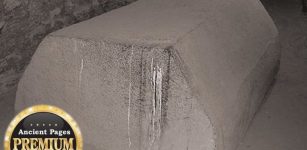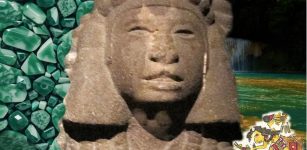Rare Bes Mugs Reveal Ancient Egyptians Drank Hallucinogenic Cocktails During Rituals
Jan Bartek - AncientPages.com - A significant discovery by a professor at the University of South Florida offers new insights that may reshape our comprehension of ancient Egyptian rituals. Professor Davide Tanasi's sophisticated chemical analyses on a rare Egyptian Bes mug have revealed the first physical evidence of hallucinogens, corroborating historical accounts and longstanding myths.
Relief of the god Bes next to the Roman north gate of the temple complex of Dendera, Egypt. Credit: Olaf Tausch - CC BY 3.0
These distinctive mugs, such as the one donated to the Tampa Museum of Art in 1984, are adorned with intricate images of the god Bes, venerated for his protective qualities and connections to fertility, healing, and magical purification.
The presence of Bes mugs in different contexts over a long period of time made it extremely difficult to speculate on their contents or roles in ancient Egyptian culture.
"There's no research out there that has ever found what we found in this study," Tanasi said. "For the first time, we were able to identify all the chemical signatures of the components of the liquid concoction contained in the Tampa Museum of Art's Bes mug, including the plants used by Egyptians, all of which have psychotropic and medicinal properties."
"For a very long time now, Egyptologists have been speculating what mugs with the head of Bes could have been used for, and for what kind of beverage, like sacred water, milk, wine or beer," said Branko van Oppen, curator of Greek and Roman art at the Tampa Museum of Art. "Experts did not know if these mugs were used in daily life, for religious purposes or in magic rituals."
Several theories about the mugs and vases were formulated on myths, but few of them were ever tested to reveal their exact ingredients until the truth was extracted layer by layer.
Tanasi, who developed this study as part of part of the Mediterranean Diet Archaeology project by the USF Institute for Advanced Study of Culture and the Environment, collaborated with USF researchers and Italian partners at the University of Trieste and University of Milan for chemical and DNA analyses. Using a pulverized sample from scraping the vase's inner walls, they combined various techniques to identify what the mug last held.
The scientists' strategy proved effective, revealing that the vase contained a mixture of psychedelic substances, bodily fluids, and alcohol. Tanasi believes this combination was used in a ritual reenactment of an Egyptian myth likely linked to fertility practices. The concoction was enhanced with honey, sesame seeds, pine nuts, licorice, and grapes—ingredients traditionally used to give the beverage the appearance of blood.
(a) Drinking vessel in shape of Bes head; El-Fayūm Oasis, Egypt; Ptolemaic-Roman period (4th century BCE—3rd century CE), (courtesy of the Tampa Museum of Art, Florida). (b) Bes mug from the Ghalioungui collection, 10.7 × 7.9 cm (Ghalioungui, G. Wagner 1974, Kaiser 2003, cat. no. 342). (c) Bes mug inv. no. 14.415 from the Allard Pierson Museum, 11.5 × 9.3 cm (courtesy of the Allard Pierson Museum, Amsterdam; photo by Stephan van der Linden). (d) Bes mug from El-Fayum, dimensions unknown (Kaufmann 1913; Kaiser 2003, cat. no. 343). Credit: Scientific Reports (2024). DOI: 10.1038/s41598-024-78721-8
"This research teaches us about magic rituals in the Greco-Roman period in Egypt," Van Oppen said. "Egyptologists believe that people visited the so-called Bes Chambers at Saqqara when they wished to confirm a successful pregnancy because pregnancies in the ancient world were fraught with dangers.
"So, this combination of ingredients may have been used in a dream-vision inducing magic ritual within the context of this dangerous period of childbirth."
See also: More Archaeology News
"Religion is one of the most fascinating and puzzling aspects of ancient civilizations," Tanasi said. "With this study, we've found scientific proof that the Egyptian myths have some kind of truth and it helps us shed light on the poorly understood rituals that were likely carried out in the Bes Chambers in Saqqara, near the Great Pyramids at Giza."
Published in Scientific Reports, the study sheds light on an ancient Egyptian mystery: The secret of how Bes mugs were used about 2,000 years ago.
Written by Jan Bartek - AncientPages.com Staff Writer






















